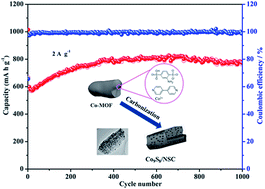Co9S8 embedded into N/S doped carbon composites: in situ derivation from a sulfonate-based metal–organic framework and its electrochemical properties†
Abstract
On account of its high theoretical capacity and excellent electrical conductivity, Co9S8 as a promising electrode material in lithium-ion batteries (LIBs) has attracted significant attention. In the present work, a simple one-step route is developed for fabricating cobalt sulfide (Co9S8) nanoparticles embedded into N/S co-doped carbon frameworks (Co9S8/NSC) using a sulfonate-based cobalt metal–organic framework (MOF) as a precursor for the first time, in which decomposition and in situ sulfidation processes are simultaneously executed in the absence of additional sulfur source. As an anode for LIBs, the hybrid composite Co9S8/NSC shows excellent reversible capacity, high rate performance and long-term cycling stability. For instance, a reversible capacity of 1179 mA h g−1 can be achieved after 200 cycles at a current density of 0.1 A g−1. When cycled at 2 A g−1, it also maintains a high specific capacity of 789 mA h g−1 after 1000 cycles. Such a superior performance may be attributed to its structural advantages that the smaller Co9S8 nanoparticles embedded into N/S co-doped carbon could enhance the active sites, electrical conductivity and cycling stability.



 Please wait while we load your content...
Please wait while we load your content...